Abstract
The peptide-binding motif of HLA-A29, the predisposing allele for birdshot retinopathy, was determined after acid-elution of endogenous peptides from purified HLA-A29 molecules. Individual and pooled HPLC fractions were sequenced by Edman degradation. Major anchor residues could be defined as glutamate at the second position of the peptide and as tyrosine at the carboxyl terminus. In vitro binding of polyglycine synthetic peptides to purified HLA-A29 molecules also revealed the need for an auxiliary anchor residue at the third position, preferably phenylalanine. By using this motif, we synthesized six peptides from the retinal soluble antigen, a candidate autoantigen in autoimmune uveoretinitis. Their in vitro binding was tested on HLA-A29 and also on HLA-B44 and HLA-B61, two alleles sharing close peptide-binding motifs. Two peptides derived from the carboxyl-terminal sequence of the human retinal soluble antigen bound efficiently to HLA-A29. This study could contribute to the prediction of T-cell epitopes from retinal autoantigens implicated in birdshot retinopathy.
Full text
PDF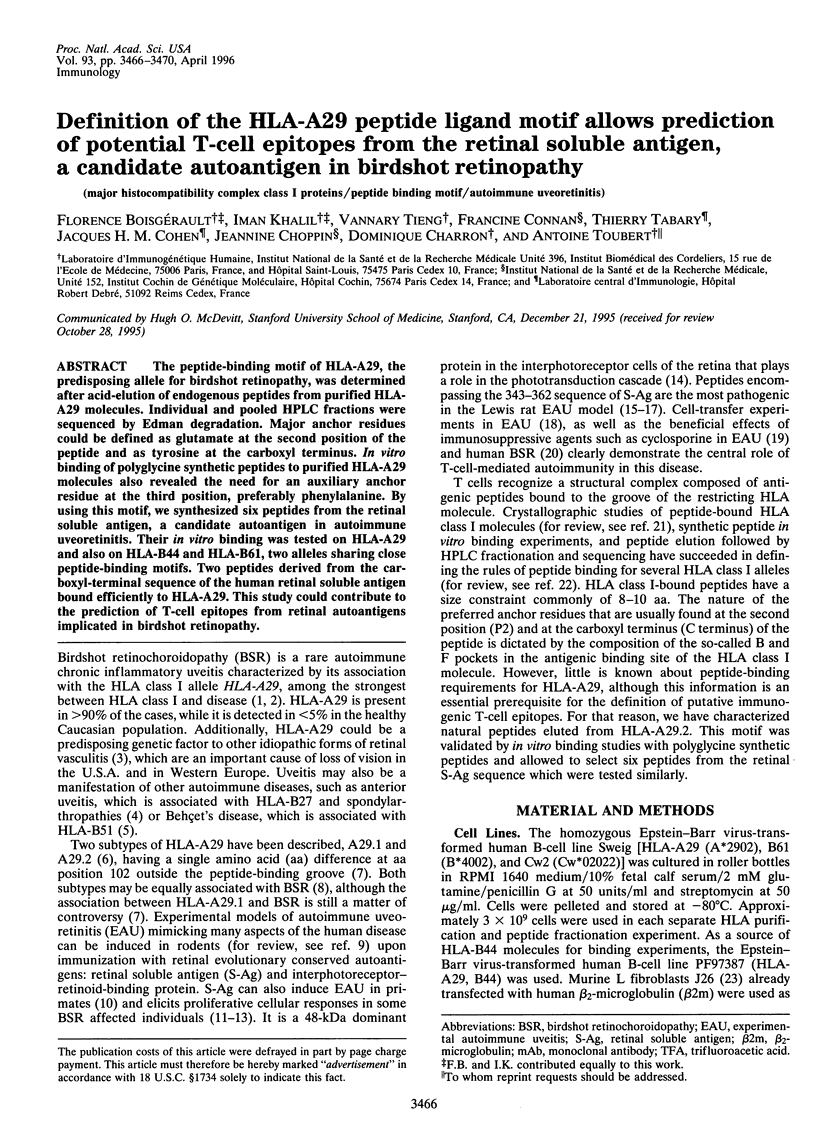
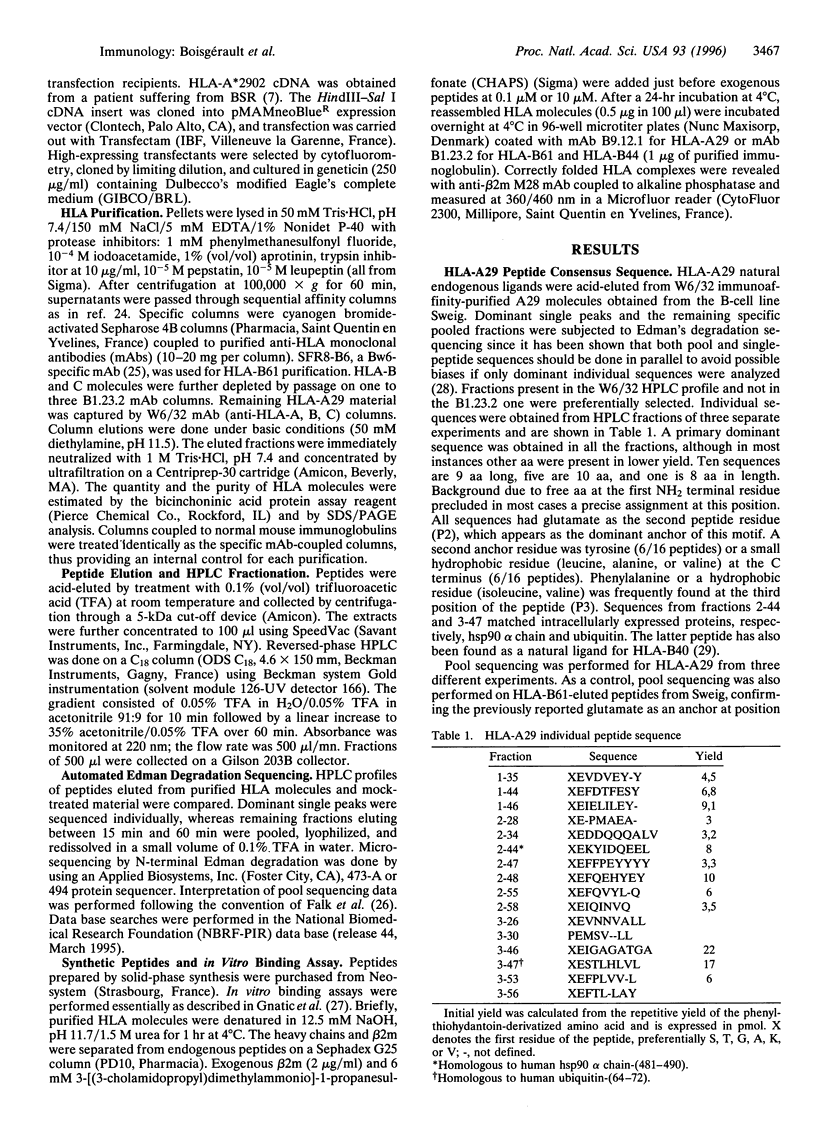
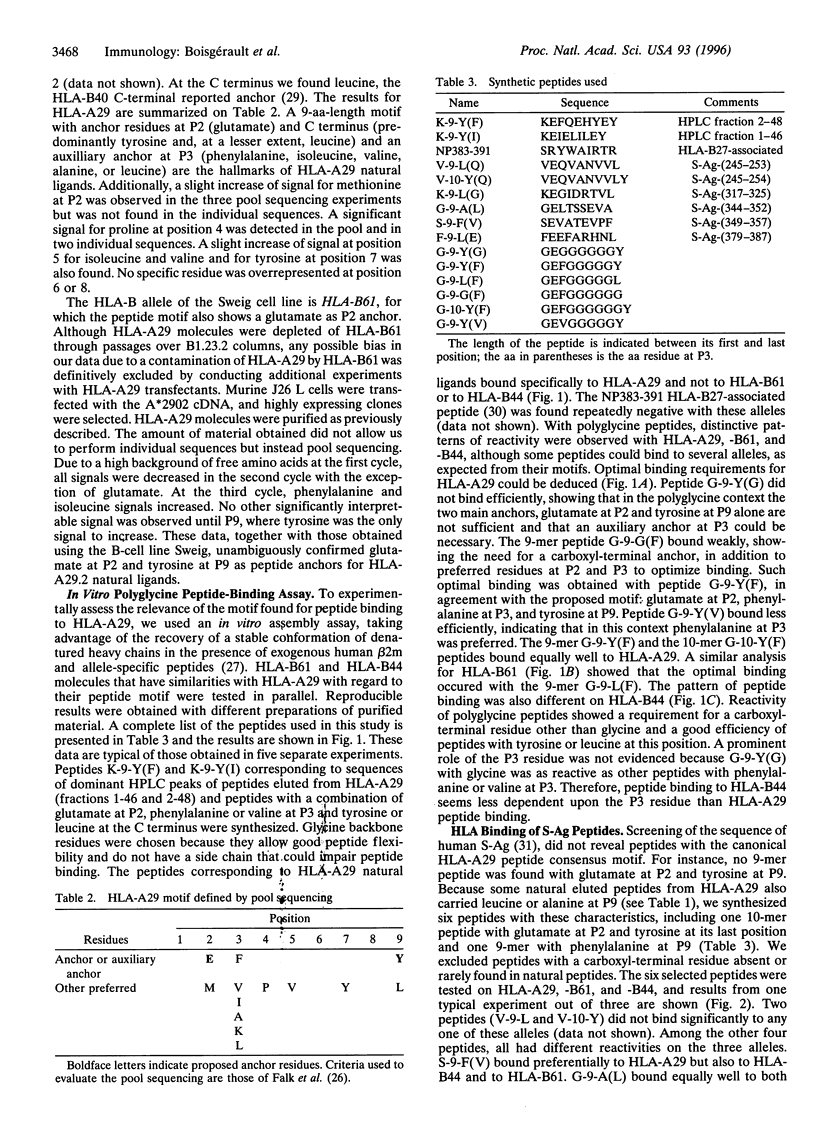
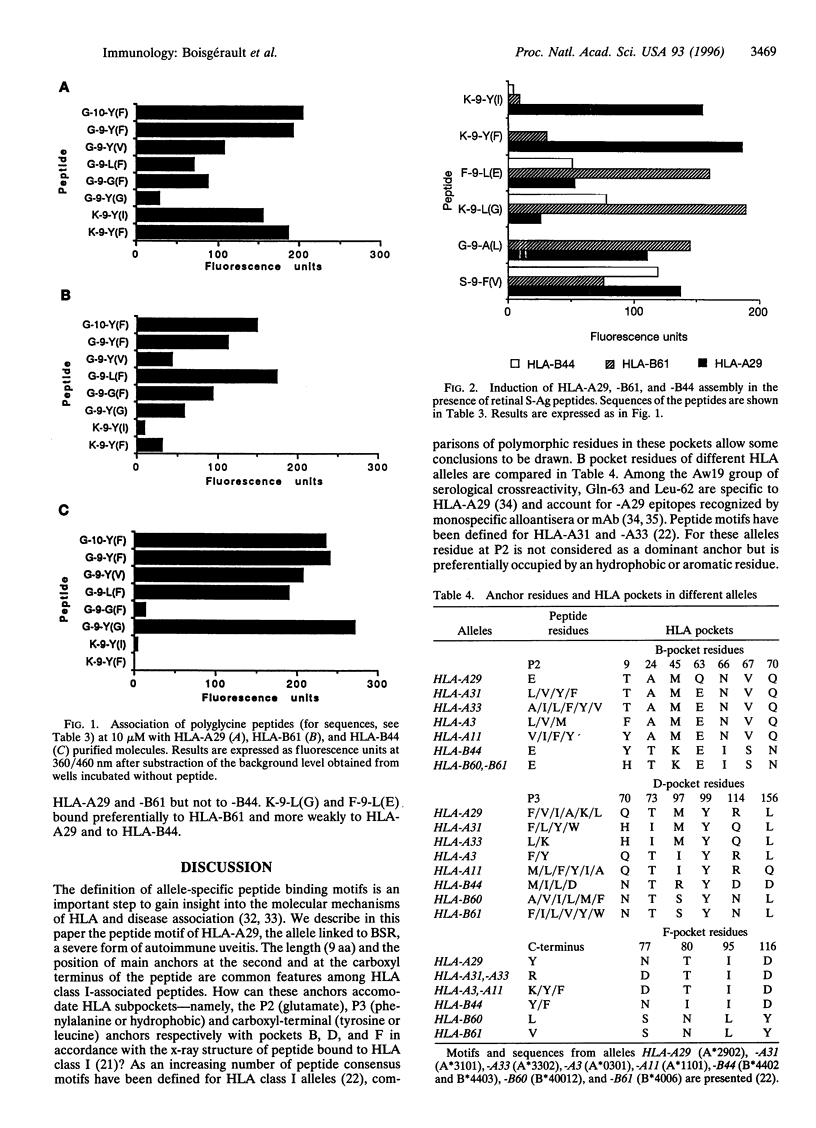
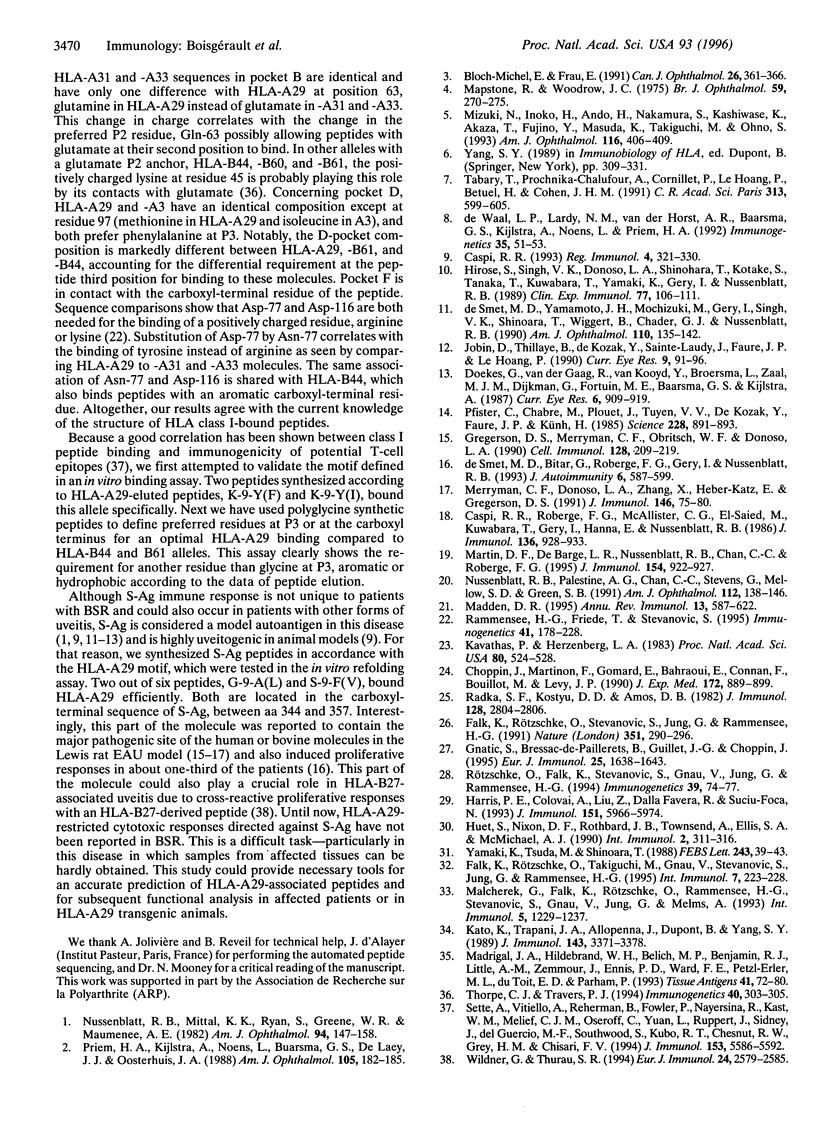
Selected References
These references are in PubMed. This may not be the complete list of references from this article.
- Bloch-Michel E., Frau E. Birdshot retinochoroidopathy and HLA-A29+ and HLA-A29- idiopathic retinal vasculitis: comparative study of 56 cases. Can J Ophthalmol. 1991 Dec;26(7):361–366. [PubMed] [Google Scholar]
- Caspi R. R. Immunogenetic aspects of clinical and experimental uveitis. Reg Immunol. 1992 Sep-Oct;4(5):321–330. [PubMed] [Google Scholar]
- Caspi R. R., Roberge F. G., McAllister C. G., el-Saied M., Kuwabara T., Gery I., Hanna E., Nussenblatt R. B. T cell lines mediating experimental autoimmune uveoretinitis (EAU) in the rat. J Immunol. 1986 Feb 1;136(3):928–933. [PubMed] [Google Scholar]
- Choppin J., Martinon F., Gomard E., Bahraoui E., Connan F., Bouillot M., Lévy J. P. Analysis of physical interactions between peptides and HLA molecules and application to the detection of human immunodeficiency virus 1 antigenic peptides. J Exp Med. 1990 Sep 1;172(3):889–899. doi: 10.1084/jem.172.3.889. [DOI] [PMC free article] [PubMed] [Google Scholar]
- Doekes G., van der Gaag R., Rothova A., van Kooyk Y., Broersma L., Zaal M. J., Dijkman G., Fortuin M. E., Baarsma G. S., Kijlstra A. Humoral and cellular immune responsiveness to human S-antigen in uveitis. Curr Eye Res. 1987 Jul;6(7):909–919. doi: 10.3109/02713688709034859. [DOI] [PubMed] [Google Scholar]
- Falk K., Rötzschke O., Stevanović S., Jung G., Rammensee H. G. Allele-specific motifs revealed by sequencing of self-peptides eluted from MHC molecules. Nature. 1991 May 23;351(6324):290–296. doi: 10.1038/351290a0. [DOI] [PubMed] [Google Scholar]
- Falk K., Rötzschke O., Takiguchi M., Gnau V., Stevanović S., Jung G., Rammensee H. G. Peptide motifs of HLA-B51, -B52 and -B78 molecules, and implications for Behćet's disease. Int Immunol. 1995 Feb;7(2):223–228. doi: 10.1093/intimm/7.2.223. [DOI] [PubMed] [Google Scholar]
- Gnjatic S., Bressac-de Paillerets B., Guillet J. G., Choppin J. Mapping and ranking of potential cytotoxic T epitopes in the p53 protein: effect of mutations and polymorphism on peptide binding to purified and refolded HLA molecules. Eur J Immunol. 1995 Jun;25(6):1638–1642. doi: 10.1002/eji.1830250625. [DOI] [PubMed] [Google Scholar]
- Gregerson D. S., Merryman C. F., Obritsch W. F., Donoso L. A. Identification of a potent new pathogenic site in human retinal S-antigen which induces experimental autoimmune uveoretinitis in LEW rats. Cell Immunol. 1990 Jun;128(1):209–219. doi: 10.1016/0008-8749(90)90019-n. [DOI] [PubMed] [Google Scholar]
- Harris P. E., Colovai A., Liu Z., Dalla Favera R., Suciu-Foca N. Naturally processed HLA class I bound peptides from c-myc-transfected cells reveal allele-specific motifs. J Immunol. 1993 Dec 1;151(11):5966–5974. [PubMed] [Google Scholar]
- Hirose S., Singh V. K., Donoso L. A., Shinohara T., Kotake S., Tanaka T., Kuwabara T., Yamaki K., Gery I., Nussenblatt R. B. An 18-mer peptide derived from the retinal S antigen induces uveitis and pinealitis in primates. Clin Exp Immunol. 1989 Jul;77(1):106–111. [PMC free article] [PubMed] [Google Scholar]
- Huet S., Nixon D. F., Rothbard J. B., Townsend A., Ellis S. A., McMichael A. J. Structural homologies between two HLA B27-restricted peptides suggest residues important for interaction with HLA B27. Int Immunol. 1990;2(4):311–316. doi: 10.1093/intimm/2.4.311. [DOI] [PubMed] [Google Scholar]
- Jobin D., Thillaye B., de Kozak Y., Sainte-Laudy J., Faure J. P., Le Hoang P. Severe retinochoroidopathy: variations of humoral and cellular immunity to S-antigen in a longitudinal study. Curr Eye Res. 1990;9 (Suppl):91–96. doi: 10.3109/02713689008999426. [DOI] [PubMed] [Google Scholar]
- Kato K., Trapani J. A., Allopenna J., Dupont B., Yang S. Y. Molecular analysis of the serologically defined HLA-Aw19 antigens. A genetically distinct family of HLA-A antigens comprising A29, A31, A32, and Aw33, but probably not A30. J Immunol. 1989 Nov 15;143(10):3371–3378. [PubMed] [Google Scholar]
- Kavathas P., Herzenberg L. A. Stable transformation of mouse L cells for human membrane T-cell differentiation antigens, HLA and beta 2-microglobulin: selection by fluorescence-activated cell sorting. Proc Natl Acad Sci U S A. 1983 Jan;80(2):524–528. doi: 10.1073/pnas.80.2.524. [DOI] [PMC free article] [PubMed] [Google Scholar]
- Madden D. R. The three-dimensional structure of peptide-MHC complexes. Annu Rev Immunol. 1995;13:587–622. doi: 10.1146/annurev.iy.13.040195.003103. [DOI] [PubMed] [Google Scholar]
- Madrigal J. A., Hildebrand W. H., Belich M. P., Benjamin R. J., Little A. M., Zemmour J., Ennis P. D., Ward F. E., Petzl-Erler M. L., du Toit E. D. Structural diversity in the HLA-A10 family of alleles: correlations with serology. Tissue Antigens. 1993 Feb;41(2):72–80. doi: 10.1111/j.1399-0039.1993.tb01982.x. [DOI] [PubMed] [Google Scholar]
- Malcherek G., Falk K., Rötzschke O., Rammensee H. G., Stevanović S., Gnau V., Jung G., Melms A. Natural peptide ligand motifs of two HLA molecules associated with myasthenia gravis. Int Immunol. 1993 Oct;5(10):1229–1237. doi: 10.1093/intimm/5.10.1229. [DOI] [PubMed] [Google Scholar]
- Mapstone R., Woodrow J. C. HL-A 27 and acute anterior uveitis. Br J Ophthalmol. 1975 May;59(5):270–275. doi: 10.1136/bjo.59.5.270. [DOI] [PMC free article] [PubMed] [Google Scholar]
- Martin D. F., DeBarge L. R., Nussenblatt R. B., Chan C. C., Roberge F. G. Synergistic effect of rapamycin and cyclosporin A in the treatment of experimental autoimmune uveoretinitis. J Immunol. 1995 Jan 15;154(2):922–927. [PubMed] [Google Scholar]
- Merryman C. F., Donoso L. A., Zhang X. M., Heber-Katz E., Gregerson D. S. Characterization of a new, potent, immunopathogenic epitope in S-antigen that elicits T cells expressing V beta 8 and V alpha 2-like genes. J Immunol. 1991 Jan 1;146(1):75–80. [PubMed] [Google Scholar]
- Mizuki N., Inoko H., Ando H., Nakamura S., Kashiwase K., Akaza T., Fujino Y., Masuda K., Takiguchi M., Ohno S. Behçet's disease associated with one of the HLA-B51 subantigens, HLA-B* 5101. Am J Ophthalmol. 1993 Oct 15;116(4):406–409. doi: 10.1016/s0002-9394(14)71396-0. [DOI] [PubMed] [Google Scholar]
- Nussenblatt R. B., Mittal K. K., Ryan S., Green W. R., Maumenee A. E. Birdshot retinochoroidopathy associated with HLA-A29 antigen and immune responsiveness to retinal S-antigen. Am J Ophthalmol. 1982 Aug;94(2):147–158. doi: 10.1016/0002-9394(82)90069-1. [DOI] [PubMed] [Google Scholar]
- Nussenblatt R. B., Palestine A. G., Chan C. C., Stevens G., Jr, Mellow S. D., Green S. B. Randomized, double-masked study of cyclosporine compared to prednisolone in the treatment of endogenous uveitis. Am J Ophthalmol. 1991 Aug 15;112(2):138–146. doi: 10.1016/s0002-9394(14)76692-9. [DOI] [PubMed] [Google Scholar]
- Pfister C., Chabre M., Plouet J., Tuyen V. V., De Kozak Y., Faure J. P., Kühn H. Retinal S antigen identified as the 48K protein regulating light-dependent phosphodiesterase in rods. Science. 1985 May 17;228(4701):891–893. doi: 10.1126/science.2988124. [DOI] [PubMed] [Google Scholar]
- Priem H. A., Kijlstra A., Noens L., Baarsma G. S., De Laey J. J., Oosterhuis J. A. HLA typing in birdshot chorioretinopathy. Am J Ophthalmol. 1988 Feb 15;105(2):182–185. doi: 10.1016/0002-9394(88)90183-3. [DOI] [PubMed] [Google Scholar]
- Radka S. F., Kostyu D. D., Amos D. B. A monoclonal antibody directed against the HLA-Bw6 epitope. J Immunol. 1982 Jun;128(6):2804–2806. [PubMed] [Google Scholar]
- Rammensee H. G., Friede T., Stevanoviíc S. MHC ligands and peptide motifs: first listing. Immunogenetics. 1995;41(4):178–228. doi: 10.1007/BF00172063. [DOI] [PubMed] [Google Scholar]
- Rötzschke O., Falk K., Stevanović S., Gnau V., Jung G., Rammensee H. G. Dominant aromatic/aliphatic C-terminal anchor in HLA-B*2702 and B*2705 peptide motifs. Immunogenetics. 1994;39(1):74–77. doi: 10.1007/BF00171803. [DOI] [PubMed] [Google Scholar]
- Sette A., Vitiello A., Reherman B., Fowler P., Nayersina R., Kast W. M., Melief C. J., Oseroff C., Yuan L., Ruppert J. The relationship between class I binding affinity and immunogenicity of potential cytotoxic T cell epitopes. J Immunol. 1994 Dec 15;153(12):5586–5592. [PubMed] [Google Scholar]
- Tabary T., Prochnicka-Chalufour A., Cornillet P., Lehoang P., Betuel H., Cohen J. H. Sous-types HLA-A29 et susceptibilité à la choroïdorétinopathie de type "Birdshot": un "motif de résistance" possible dans la molécule HLA-A29.1. C R Acad Sci III. 1991;313(13):599–605. [PubMed] [Google Scholar]
- Thorpe C. J., Travers P. J. Prediction of an HLA-B44 binding motif by the alignment of known epitopes and molecular modeling of the antigen binding cleft. Immunogenetics. 1994;40(4):303–305. doi: 10.1007/BF00189977. [DOI] [PubMed] [Google Scholar]
- Wildner G., Thurau S. R. Cross-reactivity between an HLA-B27-derived peptide and a retinal autoantigen peptide: a clue to major histocompatibility complex association with autoimmune disease. Eur J Immunol. 1994 Nov;24(11):2579–2585. doi: 10.1002/eji.1830241103. [DOI] [PubMed] [Google Scholar]
- Yamaki K., Tsuda M., Shinohara T. The sequence of human retinal S-antigen reveals similarities with alpha-transducin. FEBS Lett. 1988 Jul 4;234(1):39–43. doi: 10.1016/0014-5793(88)81298-5. [DOI] [PubMed] [Google Scholar]
- de Smet M. D., Bitar G., Roberge F. G., Gery I., Nussenblatt R. B. Human S-antigen: presence of multiple immunogenic and immunopathogenic sites in the Lewis rat. J Autoimmun. 1993 Oct;6(5):587–599. doi: 10.1006/jaut.1993.1048. [DOI] [PubMed] [Google Scholar]
- de Smet M. D., Yamamoto J. H., Mochizuki M., Gery I., Singh V. K., Shinohara T., Wiggert B., Chader G. J., Nussenblatt R. B. Cellular immune responses of patients with uveitis to retinal antigens and their fragments. Am J Ophthalmol. 1990 Aug 15;110(2):135–142. doi: 10.1016/s0002-9394(14)76981-8. [DOI] [PubMed] [Google Scholar]
- de Waal L. P., Lardy N. M., van der Horst A. R., Baarsma G. S., Kijlstra A., Noens L., Priem H. A. HLA-A29 subtypes and birdshot chorioretinopathy. Immunogenetics. 1992;35(1):51–53. doi: 10.1007/BF00216627. [DOI] [PubMed] [Google Scholar]


